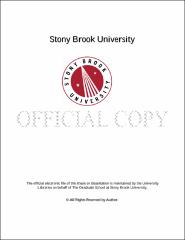| dc.identifier.uri | http://hdl.handle.net/11401/77647 | |
| dc.description.sponsorship | This work is sponsored by the Stony Brook University Graduate School in compliance with the requirements for completion of degree. | en_US |
| dc.format | Monograph | |
| dc.format.medium | Electronic Resource | en_US |
| dc.language.iso | en_US | |
| dc.publisher | The Graduate School, Stony Brook University: Stony Brook, NY. | |
| dc.type | Dissertation | |
| dcterms.abstract | We develop a multiple source inversion method that treats a large earthquake as a combination of double couple sub-events, and resolves spatio-temporal distribution and focal mechanisms of the sub-events, based on waveform modeling of P, pP, SH and sSH wave data. We study source processes of 26 large deep-focus earthquakes with Mw > 7.0 and depth > 400 km from 1994 to 2013. They are classified into three categories based on spatial distribution and focal mechanisms of the inferred sub-events: 1) category one, with non-planar distribution of the sub-events and focal mechanisms inconsistent with a single fault plane, represented by the 1994 Bolivia earthquake and the 2013 Okhotsk earthquake; 2) category two, with planar distribution but focal mechanisms inconsistent with the plane, including eighteen earthquakes; and 3) category three, with planar distribution and focal mechanisms consistent with the plane, including six earthquakes. We discuss possible physical mechanisms for earthquakes in each category in the context of plane rupture, transformational faulting and shear thermal instability. The weak initiation sub-events are studied for 6 of those earthquakes, with at least one-order smaller seismic moment. These initiation sub-events exhibit great variability of focal mechanisms as the major sub-events, and the stress drops of the sub-events can be fit in the range between 2.5 MPa and 70 MPa, however, the initiation sub-events and the major sub-events do not seem fundamentally distinguishable, implying that the earthquakes are a combination of sub-events with various magnitudes. We suggest that the inferred source processes of all the analyzed earthquakes can be best interpreted by a cascading failure of shear thermal instabilities in pre-existing weak zones, with the perturbation of stress generated by a shear instability triggering another and the orientations of the pre-existing weak zones control the focal mechanisms of pre-existing weak zones. The proposed mechanism can also explain the observed great variability of focal mechanisms and super-shear rupture of deep-focus earthquakes in the previous studies. | |
| dcterms.available | 2017-09-20T16:53:11Z | |
| dcterms.contributor | Holt, William | en_US |
| dcterms.contributor | Wen, Lianxing | en_US |
| dcterms.contributor | Ji, Chen | en_US |
| dcterms.contributor | Li, Baosheng | en_US |
| dcterms.contributor | Weidner, Donald. | en_US |
| dcterms.creator | Chen, Yu | |
| dcterms.dateAccepted | 2017-09-20T16:53:11Z | |
| dcterms.dateSubmitted | 2017-09-20T16:53:11Z | |
| dcterms.description | Department of Geosciences. | en_US |
| dcterms.extent | 268 pg. | en_US |
| dcterms.format | Monograph | |
| dcterms.format | Application/PDF | en_US |
| dcterms.identifier | http://hdl.handle.net/11401/77647 | |
| dcterms.issued | 2015-05-01 | |
| dcterms.language | en_US | |
| dcterms.provenance | Made available in DSpace on 2017-09-20T16:53:11Z (GMT). No. of bitstreams: 1
Chen_grad.sunysb_0771E_12447.pdf: 40827601 bytes, checksum: 8d9a9822734356e79da00b695887b575 (MD5)
Previous issue date: 2015 | en |
| dcterms.publisher | The Graduate School, Stony Brook University: Stony Brook, NY. | |
| dcterms.subject | cascading failure, deep-focus earthquake, multiple source inversion, pre-existing weak zone, shear thermal instability | |
| dcterms.subject | Geophysics | |
| dcterms.title | Source process and physical mechanism of global large deep-focus earthquakes | |
| dcterms.type | Dissertation | |

